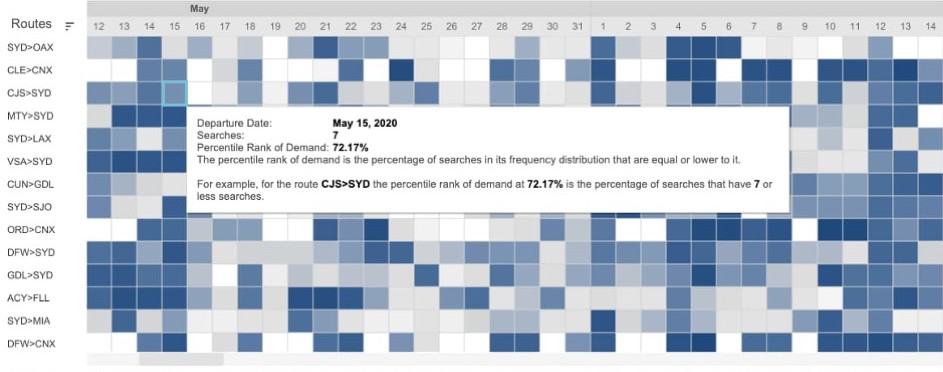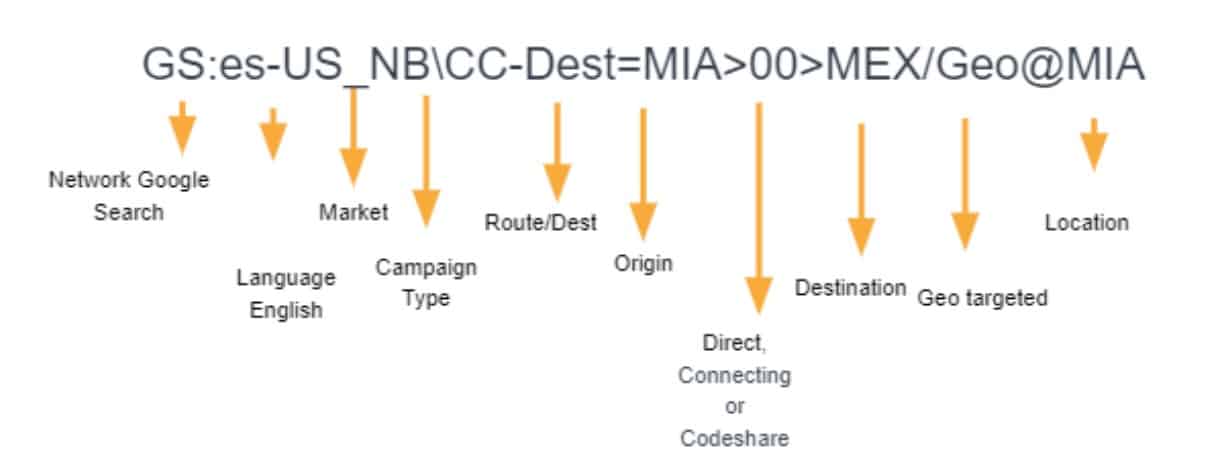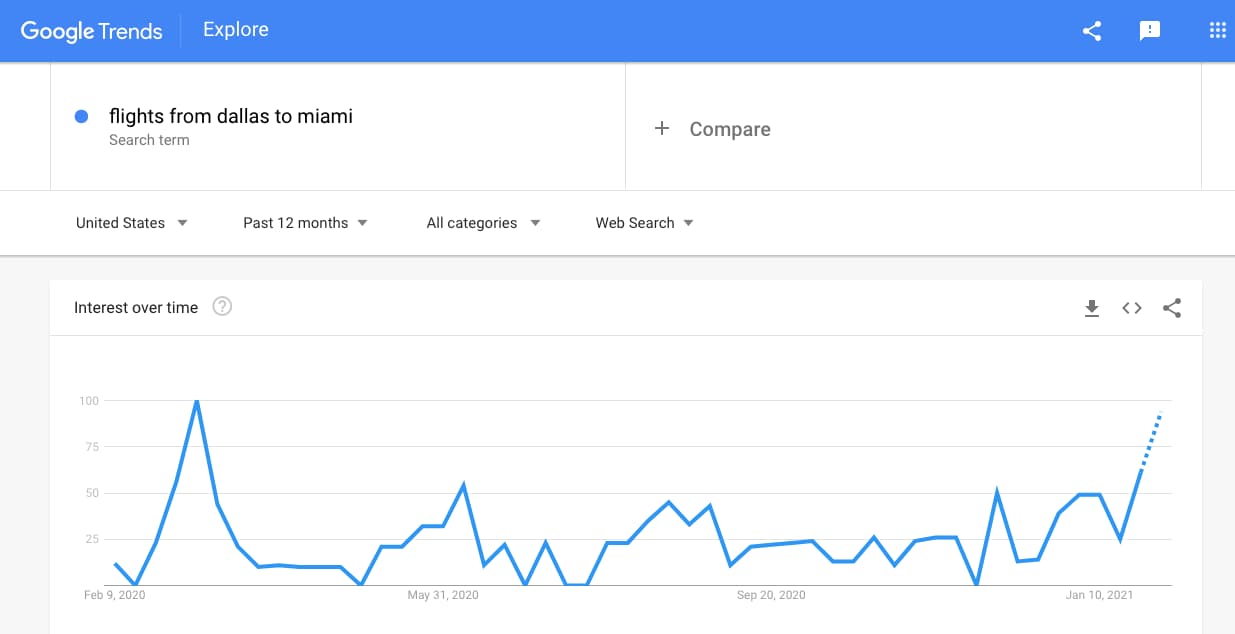Understand Demand
EveryMundo Restart & Reacquire Playbook
Tools to Understand Impact and Current Demand
Strategic network planning post-crisis can not rely on the usual sophisticated tools for route planning and pricing because those tools depend on historical data and traditional demand cues for optimization. When the Restart commences, airlines will be flying blind (no pun intended), because historical data will not shed light on market-by-market demand and willingness to pay.
In order to overcome this, EveryMundo has introduced alternative data tools to enable airlines to gauge real-time demand on a route level during this highly dynamic period. These tools will help airlines better understand the fluctuations in consumer demand and the needs of their customers, particularly in the context of their local markets.
Products that enable airlines determine demand:

FareNet collects users’ flight search behavior in real-time. With this information, EveryMundo has developed a series of dashboards to help airlines and their Revenue Management departments to make strategic decisions about budget and advertising by route and market.
By understanding changes in search, fares and bookings it is possible to adjust marketing efforts for higher efficiency and incrementality.

airSEM is a portfolio of airline-specific Search Engine Marketing tools. With these tools, airlines can find their Search Impression Share for every campaign, enabling them to understand total search demand and adjust marketing efforts.
A disciplined and granular SEM account structure empowerers airlines to understand search demand for every route.
Understand Route Search Demand
Determine what routes are in high demand – these are your strategic routes.
Tactic 1: Determine Route Demand with FareNet User Search Data
Tactic 2: Review Route Performance and Historic Average Fare
Tactic 1: Determine Route Demand with FareNet User Search Data
FareNet is EveryMundo’s proprietary pixel that is placed on an airline’s booking engine to collect in real-time the flight and fare information based on user searches. Every time a flight search is initiated by a web visitor, FareNet captures relevant information about the user search including:
- Flight Times
- Number of Passengers
- Cabin Class
- Origin & Destination
- Travel Dates
- Fares / Rewards Miles
User search data can be used as a decision making tool for network planning, by determining which routes to reopen according to traveler interest. This enables airlines to identify their most strategic routes in real-time and understand the gap between search volume and load factor in order to identify opportunities for fare adjustments.
The FareNet Demand Dashboard
The FareNet Demand Dashboard shows an airline the search volume from their website by route and day for the next 365 days. This is a decision making tool for network planning, reopening routes and increasing frequencies of existing routes based on the user interest. Airlines can use this information to plan which routes to focus on marketing and reopening first as they are the most likely flights to sell tickets.
See the FareNet Demand Dashboard with sample airline data >
FareNet Demand Dashboard will help airlines identify by route and market when their customers are planning their future trips. Read More >
Airlines can get additional granular information for each date and route on the grid by clicking an individual box. Each box displays the departure date, the number of searches for this route departing on this date (updated in real-time) and how the number searches for this route rank against the number of searches other routes in the airline’s network as a percentile. With this detailed information, airlines can get better insight into the travel dates and routes their customers are interested in and use that to improve their network planning and marketing strategies.

Note: FareNet only collects flight and fare information for every search. FareNet does not collect any personal information at any time, it passively collects and recycles the fare and flight content that any user is already looking at. The pixel fires after the page load and does not cause any additional calls to your reservations system, external GDS, or any other pricing mechanism.
Tactic 2: Review Route Performance and Average Fare
EveryMundo provides airlines with insight on their user searches, route performance, and analytics on how to optimize their Fare Marketing efforts. We have developed the Internet Booking Engine (IBE) Dashboard to provide insight into route performance, volatility in search demand and average fare.
Actionable Internet Booking Engine (IBE) Dashboard
The IBE Dashboard displays trends in demand for all airline routes, metrics such as changes in search volume, fares, revenue and bookings. Based on the data, the dashboard categorizes each route with three suggestions: Push, Reduce or Keep as is the marketing efforts. It allows the airline to also consider fare adjustments based on the user’s search intention and willingness to pay. See the IBE Dashboard with sample airline data here >

Forecast Route Search Demand via SEM
Leverage % Search Impression Share to forecast search demand across the entire airline network
Airlines can use airSEM to place paid search ads on Google that will help determine fare demand. This works by taking the Impression Share Data Google Ads Words provides for paid ads. Impression share is the number of impressions an ad received divided by the estimated number of impressions you were eligible to receive.
We recommend the tactic of bidding a little on a lot – meaning airlines should bid a small amount for every one of their routes to capture demand for their network and use that information to determine if and when they should offer more flights.
- SEM as source of demand: Enable all your network (at a small and controlled CPCs) to forecast possible available searches by market and route.
- Forecast demand with actual impressions: with % Impression Share we can forecast potential number of searches by multiplying that with the number of impressions acquired (ie. 100 impressions at a 10% IS, the forecast number of searches is 1000) for that given route and market.
- Granular and route specific naming convention: Leverage routes at a Campaign level. Having a detailed structure and treating each route as a unique product, willwill facilitate better decision-making.
Example of EveryMundo’s naming convention via airBLDR technology:

Example of impression share by campaign:

Understand Total Market Demand
Tactic 1: Monitor Global Flight Demand with the Flight Demand Tracker
EveryMundo published the Flight Demand Tracker, to provide airlines insight every day on flight demand changes by region and country. This data comes from anonymous user search data from more than 40 airlines worldwide and is updated in real-time. Airlines can use this dashboard to gain a different perspective from traditional demand data – providing a view of whether demand is falling, plateauing, or beginning to rebound – which can in turn help to inform route planning and marketing strategies.
Tactic 2: Use Google Tools for Demand Tracking
Airlines can uncover total market demand trends (beyond their own user search trends) to get insight on what routes are in demand. Use google.com/trends to compare historic data in search volume for destinations and routes. Select the query and country of interest to assess search demand corresponding to different markets.

EveryMundo Restart & Reacquire Playbooks
Understand Demand
Understand search demand for all routes to determine which routes are best to reopen, and when.
In this Playbook:
Utilize User Search Data
Forecast market demand from SEM
Sell Reopened Routes
Determine strategic routes to reopen, then acquire passengers with scalable marketing strategies.
In this Playbook:
Optimize SEM for Strategic Routes
Communicate Route Availability
Reacquire Loyal Customers
Acquire new customers and reacquire loyal customers by advertising loyalty benefits.
In this Playbook:
Promote loyalty benefits
Display real-time miles fares
Promote Deals & Offers
Compete to acquire and reacquire customers with real-time, targeted fare promotions.
In this Playbook:
Run Cross-Channel Campaigns
Promote Future Travel Today
Inform your Customers
Best practices to inform customers on and off your website.
In this Playbook:
Effectively communicate policies, restrictions and key info on and off your website at scale.
Focus SEO Efforts
Drive qualified traffic to your website with airline-specific SEO strategies.
In this Playbook:
Optimize organic search position
Maintain high SEO performance
Ready to Restart & Reacquire Customers?
We’ll show you how.
